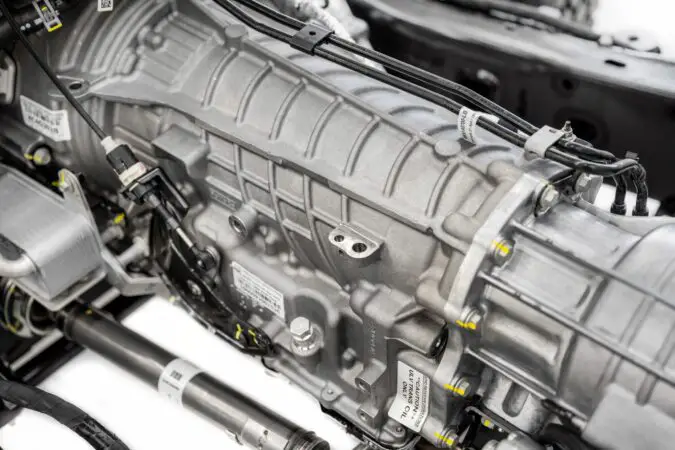Are you planning to purchase a Ford Focus and you want to learn more about the Ford Focus 2015 transmission? Well, if that is the case, then you are at the right place because in this article there will be quite a bit to cover on this topic.
Doing your own research before you decide to spend a ton of money on a car is always a good idea. You just don’t want to end up with a basket case full of problems and end up regretting that you purchased the car in the first place. As is the case when it comes to the plethora of Ford Focus transmission problems.
And trust me, there are a ton of cars out there that are problematic and have many issues. So, you always need to have your eyes open and learn more about the problems that the specific model has before you make a purchase and spend your hard-earned money on a car.
And this is why we are going to try to help you out when it comes to this. First, we are going to learn more about what is the Ford Focus and learn about the reviews that are out there about this car. Then, we will discuss the specs of the 2015 model including the engines and transmissions that were included in this model.
And after that, we will move on to the Ford Focus 2015 transmission problems and also the engine problems. So, you get an idea if this model is the way to go or if you should probably avoid it. If you want to learn more, follow along because there will be quite a lot to cover.
Ford Focus
Now before we dive into the Ford Focus 2015 transmission. Let’s discuss first about the Focus in general and learn more about the core concepts of this model. There are a lot of people curious and do not know what the Focus is and in which class of cars it belongs and want to get a little bit more grasp of knowledge on the model.
Nevertheless, the Ford Focus is a compact car that was manufactured by the Ford Motor Company since 1998. And as of 2019, there were a total of four generations released on the market.
What is interesting about this model was the fact that was developed by Ford Europe. Which is Ford’s European branch and this model was later adapted for the US market to meet US regulations. Just like the Fusion, which was basically a European Ford Mondeo.
But the difference, in this case, was that the model kept the same name for the US market.
Anyway, the important thing to know is that this model debuted in the North American market in 2000. And since this model year, it was continuously sold until its demise in 2020. The only generation that was different for the US market was the second generation produced between 2008 and 2011.
Since we are interested in the 2015 model we are interested in the 3rd generation known as the MK3. Which was launched simultaneously in Europe and North America.
This generation was basically the last generation for the US market. And since its cancellation in 2020, Ford decided to move on to other ventures and now focuses more on truck and SUV production. But what about the Ford Focus 2015 transmission? More on that, we will cover it in a bit.
2015 Ford Focus
Now that we introduced to the Focus model and we learned that this is a compact hatchback produced by Ford. Let’s take a look at one cool review on this model.
If you are in the market for a car and you still trying to learn stuff, checking out some cool reviews is always a good thing since you will be able to see other’s people’s opinions on the Focus and see what they think about it.
Then you can compare things and make sure that you get the right deal for yourself. Luckily, for you, we found a cool review done by CarGurus, specifically on the 2015 Focus and there you can see how the model is evaluated.
But what about the Ford Focus 2015 transmission? More about the transmission, we are going to elaborate in a bit. Now let’s move on and cover the rest of the specs.
2015 Ford Focus Specs
Now let’s discuss the specs of the Ford Focus 2015 before we dive into the Ford Focus 2015 transmission.
As we noted previously, this is the third generation of the Focus that was introduced for the 2011 model year and was produced until 2019, when it was discontinued here in the US. This generation is known as the MK3. So, if you read this name on some forum or other online discussions, it shouldn’t confuse you.
Nevertheless, the model was assembled in the US locally, more specifically in Wayne, Michigan at the Michigan Assembly Plant by Ford. The model is also assembled globally in a lot of other Ford factories for other markets around the globe.
Another important detail about this model was the One Ford plan by the CEO of Ford Allan Mulally. With the goal to create one single model for all the global markets where Ford is selling their vehicles. But enough on that, let’s now move to the specs, including the Ford Focus 2015 transmission.
Dimensions, Size & Practicality
Now let’s take a look at the dimensions and size before we discuss the ford Focus 2015 transmission. The first thing to note is that this model comes in a few body styles. But for the US market, the most popular were the 5-door hatchback and the 4-door sedan.
The wheelbase for all of the models is the same, at 104.3 inches. While the length differs anywhere between 171.6 inches for the hatchback and up to 178.5 inches for the sedan version.
The model is 71.8 inches wide and 58.4 inches tall. The curb weight of this model varies from 2,800 lbs and up to 3,243 lbs for the standard models and up to 3,459 for the RS sport version.
The weight difference is there because the sport model implements a heavier engine and more equipment than the regular versions of the Focus.
If you want something lighter, you might want to opt for the Fiesta. But take note that this model is less spacious and can be somewhat of a tight fit for most people out there. For more specifics, do head over to our guide on the reliability of the Ford Fiesta, as well as the 2011 Ford Fiesta problems.
But what about the Ford Focus 2015 transmission? More on that, we will find out next.
Engine & Ford Focus 2015 Transmission
Now let’s discuss more about the powertrain options that were present in the 2015 model, including the Ford Focus 2015 transmission.
But let’s start with the engines included in the model. What is worth noting is that there was only one engine available for the 2015 model.
The engine used was the 2.0L inline-4 turbocharged EcoBoost engine. This is a really modern engine in comparison to what Ford used previously on their cars.
The 2.0L engine was making about 160hp and 146lb-ft of torque. This engine implements an inline-4 layout with a turbocharger. This is also a direct injection engine, which means that the fuel is injected directly from the top of the cylinder by high-pressure injectors.
This greatly improves the fuel efficiency of the model and more on that, we are going to learn more next. In terms of the Ford Focus 2015 transmission, it is worth noting that there were two transmissions available. One of them was a 5-speed manual that came with the base S and SE models.
But there was also a 6-speed automatic offered on all the models as well. And this is the transmission that we are interested in.
The specific model is known as the PowerShift transmission and this transmission was a dual-clutch automatic and was developed by Ford. What is worth noting is that the transmission was plagued with problems.
More specifically the dry clutch packs were relatively cheap and often caused a lot of issues that we are going to discuss later on when we are going to cover the Ford Focus 2015 transmission problems.
Fuel Economy
Now let’s take a look at the fuel economy of the Focus before we dive into the Ford Focus 2015 transmission problems. Is this model considered to be fuel-efficient?
Well, yes, the model, specifically the 6-speed automatic version can deliver about 27 mpg in the city and 40 mpg on the highway, with a combined fuel economy of 31 mpg. Which is a really healthy number.
The 5-speed manual on the other hand is somewhat worse. This model gets about 26 mpg in the city, 36 mpg on the highway, and 30 mpg combined. So, if you can afford this model, we would recommend it since it does not have the same Ford Focus 2015 transmission problems as the automatic.
Safety
Now let’s discuss the safety of the Focus before we dive into the Ford Focus 2015 transmission problems.
What is worth noting about the model is that the Focus was tested by the IIHS, which is one of the main governing bodies in the US when it comes to car safety along the NHTSA. And they crashed this model on purpose to determine its strength.
And overall, the model performed well. Even though not the greatest performance of a car. It got “Good” scores on most tests. But the cage structural integrity was under question and in this segment, it got a “Marginal” score and the overall score for the model was “Acceptable”.
Which is somewhat good considering that this is a compact car. Even though the cage crumbled a bit, the chances for leg injuries were low as they noted on the tests.
Ford Focus 2015 Value
Now before we discuss the ford Focus 2015 transmission problems, let’s take a look at the value of this model and the money that you will have to pay in order to get one of these models.
We visited Autotrader.com and on this site, you have a lot of listings from all across the country. And the low-end price for which you could find this model is about $4,000.
But these are usually higher mileage vehicles that have a ton of miles on them. Most of them have around 150,000 miles on the clock. For a decent lower mileage model, you can expect to pay about $8,500. Which is a really good deal. But what about the Ford Focus 2015 transmission problems? More about that, we are going to cover next.
2015 Ford Focus Problems
Now let’s move on and discuss more about the problems of the Ford Focus. Including the Ford Focus 2015 transmission problems.
In the following chapters, first, we will cover the engine issues with the 2.0L engine. Then we will move on to the problematic PowerShift transmission and then we will cover the other miscellaneous issues including the recalls and reliability. So, if you want to learn more, follow along.
Ford Focus 2015 Engine Problems
When it comes to the 2.0L engine that this model has, we can say that it is rather reliable. Even though there were three reports on carcomplaints.com that indicate engine failures.
When it comes to other common problems, we can list the common cracks developing on the exhaust manifold. The high temperatures make the exhaust manifolds prone to cracking and developing problems. And if it happens, there will be issues like check engine light, whistling noise, a poor boost for the turbo, etc.
For more context, do refer to our write-up on what an exhaust manifold leak is, and how to repair an exhaust manifold, as well as the cost of replacing an exhaust manifold.
Another very problem is the boost solenoid that can fail on these engines and cause poor engine performance and lack of engine power. The check engine light and the error code P0299 are also quite common.
And last but not least is the excessive carbon buildup on the intake valves. This engine implements a direct injection. This means that because of this design, there will be increased carbon buildup.
So, in order for you to solve the problem, you will have to take your engine for a walnut blasting procedure in order for the problem to be sorted out and the valves cleaned. This is recommended to be done every 80,000 miles.
But what about the Ford Focus 2015 transmission problems? More about the transmission problems, we are going to elaborate next.
Ford Focus Transmission Problems
Now let’s discuss more about the Ford Focus 2015 transmission problems and see more about the issues that were reported on this model.
As we noted, this model was equipped with the notorious Ford PowerShift transmission and this transmission was very problematic.
On carcomplaints.com, there are a total of 40 complaints concerning the transmission shudder and 13 reports on problems with the clutch pack on this transmission, which is the real cause of this problem on the Focus.
Nevertheless, this dual-clutch transmission, even though it is really reliable and rarely fails. It is very prone to create unbearable symptoms of transmission shudder, and vibrations inside the cabin when the vehicle accelerates. Especially on inclined roads.
This was so annoying that many people filed class action lawsuits against Ford according to the official Wikipedia article on the PowerShift transmission.
All these issues were caused by the dry clutch packs that were used in this transmission. A dry clutch is basically a clutch that works without transmission fluid, like the one found in manual transmission cars.
So, this made the engagement of these dry clutches very harsh not very rough compared to the wet oil-bathed clutches. This created vibrations and a lot of heat inside the transmission. But didn’t cause the transmission to fail. This is good since having these symptoms does not mean that the transmission will fail.
What Ford did to solve this was releasing the 2015 Ford Focus transmission shudder fix on the seals, as well as the inclusion of updated clutch kits that sorted the problem on the Ford Focus 2015 transmission.
Another failure point on these PowerShift automatics was the Ford Focus transmission control module which was also prone to failure.
Other Miscellaneous Problems
We covered the Ford Focus 2015 transmission, now let’s move on and learn more about the other miscellaneous problems that this model has.
The biggest problem concerning this model year of the Focus is the power steering failure. The power steering system can fail on this Focus and basically leave you without power steering. This is a problem that requires about $2,500 to get sorted out since the steering gear inside has to be replaced.
This is why you should make sure that the power steering system is sorted out in your Focus and works well. If it makes noises, avoid this car unless you want to pay for the fix.
Other minor problems with the Focus include headliner squeaks and rattles, the child safety lock not working, and problems with the infotainment system.
Also, there were some reports of a clogged catalytic converter. The catalytic converter is an emissions device that can get clogged up and cause problems for you as a driver. And this component is also expensive to fix, it costs about $1,400 on average to get it sorted out.
Otherwise, you should be diligent about the signs of a bad catalytic converter (and how to tell if catalytic converter is bad), in addition to the symptoms of a clogged catalytic converter. Otherwise, you don’t necessarily have to replace the entire thing, as using a simple catalytic converter cleaner, or knowing how to unblock a clogged catalytic converter can sometimes be enough.
Except for that, there were also reports of poor craftsmanship by Ford and paint chipping (which is pretty bad, unless you know how to fix paint chips on car), water leaks inside of the cabin, problems with closing the trunk lid, and other minor imperfections. But what about the recalls? Well, more about that, we are going to elaborate next.
2015 Ford Focus Recalls
Another topic that we would like to cover since we learned more about the Ford Focus 2015 transmission problems is the issue with the recalls. How many recalls were done on the 2015 model?
For the 2015 model, there were 6 recalls in total according to cars.com. The most important recalls were connected to the gas tank, where could happen excessive vacuum which can lead to an engine stall. As well as a recall for the manual transmission cars. Where a transmission fluid leak can cause an engine fire in the engine compartment.
For the other recalls, you can check more in detail in the following link. But is this model reliable? Let’s find out more about that next.
2015 Ford Focus Reliability
We covered the Ford Focus 2015 transmission and learned more about the problems that this model has. But is this model reliable?
Well, the reliability of this model is decent. Especially the 2.0L engine which is very praised for its reliability. The only drawback is the transmission which can be somewhat problematic and cause a shudder or other shifting problems. But what is good is that it does not fail. These problems are only due to the dry clutch packs.
If you’re curious about getting a used example, you can check out our guide on are Ford Focus good cars. For more specific model years, we’ve also covered the 2013 Ford Focus problems, as well as the 2014 Ford Focus problems.
Conclusion
In this article, we covered quite a lot when it comes to the Ford Focus. Firstly, we learned what the Focus is and we covered most of the specs of this specific model. Then we discussed the mpg ratings, as well as the price.
In the second part of the article, we discussed the problems, including the engine problems, the Ford Focus 2015 transmission problems, and other miscellaneous issues.
Frequently Asked Questions
Now let’s answer some frequently asked questions.
How Long Does A Ford Focus Last
A Ford Focus should easily last at least 200,000 miles. On average most of these cars last up to 250,000 miles before requiring an engine replacement or other major repairs to be done.
How Long Do Transmissions Last
A manual transmission easily lasts as long as the vehicle. It might require a clutch replacement eventually but this is an expendable component. On the other hand, automatics, especially CVTs last very little. Some even fail below 100,000 miles. But on average an automatic if well maintained should last at least 150,000 miles.
What Causes Transmission Problems
Transmission problems can be caused by many factors. Mainly poor usage and maintenance. If you push the car too hard, the transmission can overheat. Or if you don’t maintain it, will start to develop problems.
What Does Dual Clutch Mean
A dual-clutch transmission is a type of automatic transmission that implements a dual-clutch design inside. Unlike the classic torque converter automatic, this type of transmission is more compact and also delivers snappier shifts.
How To Drive A Dual Clutch Automatic Transmission
The same way you drive any automatic transmission out there. Dual-clutch transmissions are not very different than your standard automatic transmission in terms of operation.
What Causes Transmission Shudder
This is a situation that often happens when the fluid inside of the transmission gets dirty or contaminated. These contaminants will affect how the transmission behaves and there will be some shudder or other strong vibrations if there is no proper flow in the valve body.





